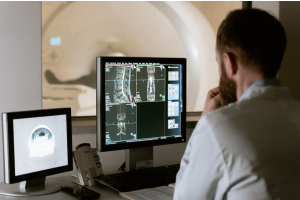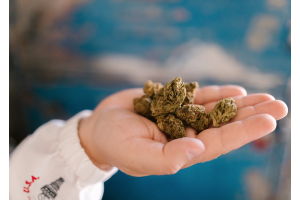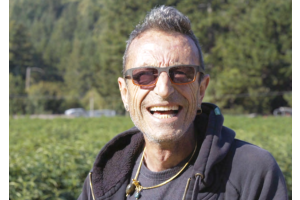Eat and Drink to Reduce the Health Risks of Smoking Cannabis

Cannabis can be consumed by mouth in one of three ways. The most popular is by inhaling its smoke or vaping. Among epicures, cooking and eating the herb is their favorite. The third, least common way is infusing it and then spraying or drinking the tincture.
Yet, after smoking cannabis, you still should consider eating or drinking, just not cannabis, because with what you eat and drink, you can prevent nutrient loss and tooth decay caused by smoking.
Tooth or Consequences
Smoke and vape, be they of tobacco or cannabis, are both hot and dry, which parches your mouth and throat. Cannabis goes one step beyond tobacco. Cannabinoid receptors reside throughout the body, including in your mouth’s salivary glands.[i] THC ingested by any means, be it by smoke, food, or tincture, causes the salivary glands to dry up[ii] and shut down.[iii] After smoking cannabis, your mouth can remain parched for up to six hours.[iv] That’s a long time to be left feeling high and dry.
More than a mere discomfort, a dry mouth poses serious health risks. Saliva dissolves and washes away sugars and bacterial deposits, so any decrease in saliva can cause bad breath,[v] tooth decay,[vi] and gum disease.[vii] Though cannabis smokers risk gum disease more than tooth decay,[viii] both can lead to tooth loss.
Soon after smoking, restore moisture to your dry gums and wash tar from your teeth by rinsing your mouth with water. Even better, drink the dang stuff. Drink your water straight, undiluted, and unflavored, not in beverages that contain water. Pure water is an undervalued nutrient that deserves to be appreciated as milk from Mother Earth.
If you can’t drink water, chew some sugar-free gum. Chewing activates salivary glands. Eating food activates those spit glands, too. Best of all, chew on something green and leafy. Parsley serves as more than a garnish decorating a dinner plate. It cleanses the palette after a meal, especially one containing garlic. The chlorophyll inside any leaf is a powerful cleanser and breath freshener. No leafy green nearby? Oh, yes, there is. What do you think you’ve been smoking?
Health Tip to Remedy Dry Mouth: To remoisten your parched mouth and throat after smoking, drink water or chew on a leafy green.
When Smoke Gets in Your Eyes
The longer the stem of your pipe or cigarette holder, the less smoke you will get in your eyes. In addition to smoke in the air irritating your eyes, THC can make your eyes feel dry, the same as in your mouth. Only people who wear contact lenses might notice that.[ix] Some say peeling onions right after smoking cannabis does not make them cry.[x]
Comfort Tip to Prevent Scratchy Eyes: To prevent eye irritation, stay thoroughly hydrated before smoking, and drink water after smoking.
Sorry for Your Loss
Except for the nicotine in tobacco and the cannabinoids in cannabis, the smoke from the two herbs is quite similar. The nutrient loss from smoking tobacco is well documented, but there is no research about how smoking cannabis, too, might adversely affect your body’s storage and usage of nutrients. Until such research is conducted, we can filter out the information specific to nicotine and then deduce the results relevant to smoking generally. The nutrients cited here are not the full roster but just the highlights. In addition to listing below some nutrients depleted by smoking, some foods are paired with them that can compensate for your loss.
ACE It
Vitamin A, C, and E (ACE) levels are mostly lower in smokers than in nonsmokers due to the oxidative stress of smoking.[xi] The ACE vitamins are antioxidants that protect the skin, and the lungs are skin turned outside-in.
Vitamin A aids in healing mucous membranes.[xii] Count the mouth, throat, and lungs linings as mucous membranes. Rich dietary sources include animal livers, the dark green leaves of vegetables, and orange- and yellow-colored fruits and veggies.[xiii]
Vitamin C is quickly depleted in smokers.[xiv] The smoke from a single tobacco cigarette depletes 25mg of C,[xv] half of the fresh orange. This vitamin is found only in plant foods. Among fruits, citrus and berries excel. Among veggies, any greens or microgreens provide an abundant source of leafy greens; the darker the green, the better.[xvi]
Vitamin E levels in smokers show reductions from years spent smoking.[xvii] The vitamin protects the lungs from damage and heals any damage done.[xviii] It is concentrated in oils, liver, eggs, nuts, seeds, and grains.[xix] Sunflower seeds excel among seeds and almonds among nuts.
Shine a Light on the Sunshine Vitamin
Vitamin D is aptly called the “sunshine vitamin.” You can make your own by exposing your skin to the sun. The D you produce yourself is better assimilated than when you pop D as a pill.[xx] If you prefer to have someone else make it for you, sources from the animal kingdom include fish, oils derived from animal livers, and irradiated cow milk. It is absent from the plant kingdom except in wild or specially cultivated mushrooms.[xxi] A deficiency is associated with increased susceptibility to bronchitis, flu, and other respiratory infections,[xxii] the same illnesses to smoking cannabis make you more susceptible.
The go-to minerals that work with vitamin D are selenium and zinc to strengthen lung tissue. Selenium levels in smokers are low due to inflammation in the lungs caused by smoke.[xxiii] The richest source of both flora and fauna is the Brazil nut. It is also found in sea animals, grains, and beans.[xxiv] Zinc is essential for an optimal immune system—the folk remedy of eating oysters to boost virility hinges on its high content of zinc. As the second highest source, pumpkin seeds will get you pumpin’.[xxv]
Every Mouthful Counts
To compensate for what’s depleted by smoking, do I need to eat three carrots for vitamin A, two oranges for C, some sunflower seeds for E, some wild mushrooms for D, some Brazil nuts for selenium, some pumpkin seeds for zinc, and do I need to eat them daily, or can I skip a day? Which would I lose first, my appetite or my count?
There’s an easier way. While few nutritionists agree upon what foods to eat, most have decided on what not to eat. To counteract the ill effects of tobacco smoking, one bestselling author unequivocally implores smokers not to consume junk foods, processed foods, saturated fats, white flour, sugar, and salt.[xxvi] That’s sound advice for smokers and nonsmokers alike.
Since 1945, two new food groups have entered our lives and lexicons: junk and fast foods. Simple and easy! Just by eliminating white flour and white sugar from your diet, you’ll avoid most junk foods and be left with only the foods that compensate for the nutrients lost to smoking.
Chew on This
We can devote years to researching the crucial life-or-death matter of nutrition or simply eat only whole and natural foods. What defines natural food? Natural food on your plate looks almost the same as on the farm. By such a definition, herbal cannabis is a natural drug. Except for being dried, the cannabis in your stash looks the same as it did on the stalk. That earthy sensuality may unwittingly be why you choose to smoke cannabis in its whole and natural herbal form.
There are far more cannabinoids and terpenes to be found in whole herbal cannabis than appear listed on any label. The same reasoning applies to eating whole foods rather than resorting to nutritional supplements whose contents are restricted to only what is listed. Food comprises far more than the sum of its few isolated parts. Scientists continue to discover new nutrients in plant foods that, until now, no one imagined even existed. Some newbies are phytonutrients found only in plants. Many phytonutrients act as antioxidants.[xxvii] Antioxidants protect the lungs against radiation, air pollution, and smoke. The most common type of phytonutrient is terpenes. That’s right, the terpenes in cannabis flowers are phytonutrients. Heat destroys or reduces the bioactivity of antioxidants, so by smoking cannabis, we destroy many of its antioxidants. Fortunately, we can eat other plants raw.
Want a nutritional boost? Among veggies, leafy greens stand out for their phytonutrients. And cannabis is a vegetable whose leaves gleam green. If you grow your own or otherwise have access to fresh cannabis leaves, try juicing them. An entire healing therapy has sprouted up around freshly juiced raw cannabis.[xxviii] One doctor has devoted much of his medical practice to supervising patients who drink raw cannabis juice for its therapeutic properties.[xxix] The next frontier of cannabis research might show that eating its raw leaves can counteract any harm risked by smoking its flowers. Stay tuned.
Health Tip for Smokers: Smokers and nonsmokers should avoid eating junk foods, processed foods, refined grains, saturated fats, salt, and sugar. If you cling to your lifelong food habits, then to compensate for nutrients depleted by smoking, at least add to your diet generous portions of foods rich in vitamins A, C, E, and D, and minerals selenium and zinc. And then you can breathe a long sigh of relief!
+ + +
Mark Mathew Braunstein has contributed to many holistic health magazines, including Natural Health and Vegetarian Times. He is the author of six books, including Microgreen Garden and Mindful Marijuana Smoking: Health Tips for Cannabis Smokers (Rowman & Littlefield Publishers, 2022), from which this article was adapted. You can read his many editorials and articles about medical marijuana and recreational cannabis, including previously in Weed World, at www.MarkBraunstein.org
[i] Juan Pablo Prestifilippo, et al., “Inhibition of Salivary Secretion by Activation of Cannabinoid Receptors,” Experimental Biology and Medicine 231, no. 8 (September 1, 2006): 1428, https://doi.org/10.1177/153537020623100816.
[ii] S. Joshi and M. Ashley, “Cannabis: A Joint Problem for Patients and the Dental Profession,” British Dental Journal 220, no. 11 (June 10, 2016): 599, https://doi.org/10.1038/sj.bdj.2016.416.
[iii] Prestifilippo et al., “Inhibition of Salivary Secretion,” 1421.
[iv] Joshi and Ashley, “Cannabis: A Joint Problem,” 598.
[v] Joshi and Ashley, “Cannabis: A Joint Problem,” 600.
[vi] Fawad Javed, et al., “Periodontal Conditions and Whole Salivary IL-17A and -23 Levels among Young Adult Cannabis Sativa (Marijuana)-Smokers, Heavy Cigarette-Smokers and Non-Smokers,” International Journal of Environmental Research and Public Health 17, no. 20, article 7435 (October 13, 2020), 7, https://doi.org/10.3390/ijerph17207435.
[vii] John Edward Swartzberg, Sheldon Margen, and the Editors of UC Berkeley Wellness Letter, The Complete Home Wellness Handbook (New York: Rebus Books, 2001): 287.
[viii] Mark Tambe Keboa, et al., “Oral Health Implications of Cannabis Smoking: A Rapid Evidence Review,” Journal of the Canadian Dental Association 86, (February 3, 2020):6–7, https://jcda.ca/k2.
[ix] Andrew Weil and Winifred Rosen, From Chocolate to Morphine: Everything You Need to Know about Mind-Altering Drugs, revised ed. (Boston: Houghton Mifflin, 2004), 137.
[x] Peter Stafford, Psychedelics Encyclopedia, third ed. (Berkeley, CA: Ronin Publishing, 1992), 189.
[xi] Christine A. Northrop-Clewes and David I. Thurnham, “Monitoring Micronutrients in Cigarette Smokers,” Clinica Chimica Acta 377, no. 1–2 (February 2, 2007): 14, https://doi.org/10.1016/j.cca.2006.08.028.
[xii] Phyllis A. Balch, Prescription for Nutritional Healing, fourth ed. (New York: Avery, 2006), 709.
[xiii] Balch, Prescription for Nutritional Healing, 17.
[xiv] Balch, Prescription for Nutritional Healing, 708.
[xv] Ross Trattler and Adrian Jones, Better Healing through Natural Health, second ed. (New York: McGraw-Hill, 2001), 433.
[xvi] Balch, Prescription for Nutritional Healing, 24.
[xvii] Northrop-Clewes and Thurnham, “Monitoring Micronutrients,” 25.
[xviii] Balch, Prescription for Nutritional Healing, 709.
[xix] Balch, Prescription for Nutritional Healing, 27.
[xx] Balch, Prescription for Nutritional Healing, 25.
[xxi] Balch, Prescription for Nutritional Healing, 25.
[xxii] Aranow, “Vitamin D,” 882.
[xxiii] Northrop-Clewes and Thurnham, “Monitoring Micronutrients,” 30.
[xxiv] Balch, Prescription for Nutritional Healing, 38.
[xxv] Balch, Prescription for Nutritional Healing, 40.
[xxvi] Balch, Prescription for Nutritional Healing, 710.
[xxvii] Robinson, Eating on the Wild Side, 5.
[xxviii] Kat Austin, “Juicing Cannabis: Medicine without the High,” Key to Cannabis, July 28, 2019, https://keytocannabis.com/juicing-cannabis-medicine-without-the-high/.
[xxix] “Resources,” Cannabis International, accessed September 11, 2022, https://cannabisinternational.org/wordpress/index.php/resources/.
Written and Published by Mark Mathew Braunstein in Weed World Magazine issue 161
Image: Pexels












Validate your login